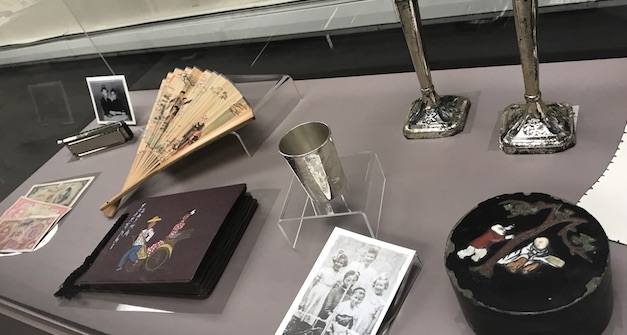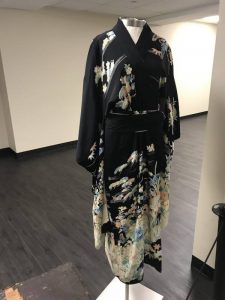
As the world prepares to mark International Holocaust Remembrance Day on Jan. 27, a recently unveiled exhibit at a Holocaust museum in Brooklyn tells the largely untold story of Eastern European religious Jews who fled the Nazis and found refuge in Shanghai.
The Amud Aish Memorial Museum last October launched “A Precious Gift: Escape to Shanghai,” featuring original artifacts that give a glimpse into the lives of Orthodox Jews starting from their time in Eastern Europe before World War II, through their travels to Shanghai and ultimately their religious life in China before they found a permanent home elsewhere. The exhibit also highlights the heroic efforts of worldwide government officials who risked everything to help Jews and explains how Shanghai was a safe haven because it did not require entry visas and maintained open borders for all immigrants until the late 1930s.
The many artifacts on display in the exhibit include a transit visa issued by Japanese Vice Consul in Lithuania Chiune Sugihara, who disobeyed orders from his superiors and authorized travel papers for Jews; sacred religious texts printed by Jewish refugees in Shanghai; candlesticks with Chinese writing on them bought by a Polish Jew in Shanghai; and a marriage contract from a Jewish wedding that took place in China after the war.

Small group workshops, catered for middle school students, accompany the exhibit and focus on an individual story of a Holocaust survivor. One such workshop explores the experience of Judith Cohn-Goldbart, a Jewish girl whose family left Berlin for Shanghai shortly after Kristallnacht in 1938. She remained in Shanghai until years after the war and was a teacher at the religious girls’ school established there. Participants in the group workshops are given the opportunity to examine copies of original artifacts from Shanghai, such as a Jewish student’s report card.
“It feels like they’re touching history,” Chavi Felsenburg, acquisitions curator at the Amud Aish Memorial Museum and leader of many of the workshops, told JNS. “It just makes the story more real. It puts all the information that they gathered together in perspective.”
She added, “I think people leave inspired. It really does affect them…[within] the groups that come, very often I’ll have someone raising their hand saying, ’This was my grandmother. This was my aunt.’”
Dovid Reidel, director of the museum’s research and archive division, said Amud Aish received its first collection of artifacts related to Shanghai in 2013, the same year the museum opened. The vast collection the museum received at the time included notes a Jewish refugee kept from his doctors in Shanghai, pamphlets that came with medication he bought and X-rays of his eyes. Another early Shanghai collection the museum received belonged to Cohn-Goldbart and was discovered by relatives who emptied her Los Angeles home after she died. They donated documents and items to the museum in large shopping bags, unsure of what exactly they possessed, but hoping the museum would give them some answers.
The museum, which is located in a mainly residential area of Brooklyn, focuses on the Holocaust from the vantage point of Orthodox Jews—how they lived, how they maintained their religion and more. Many items in the Shanghai collection were donated by Orthodox Jews who preferred not to give the items to any other museum, Felsenburg said.
“A lot of times donors will tell me that they feel like the people who perished [in the Holocaust], that is what they would like to have: that continuous connection to God,” she said. “They thought maybe it wouldn’t come across in other museums the same way. It’s more from a cultural perspective, but not from a spiritual one. So even though some of the items were ordinary items that other people might have too, it’s about what they meant to these people.”
A ‘gift’ from God
The museum named this year’s exhibit “A Precious Gift” for a number of reasons, Reidel explained.
“On one hand, it talks about that it really was a gift from Hashem, the opportunity for several thousand—the number is about 20,000—Jews to be rescued through Shanghai, so that was really an amazing success story,” he said. “But part of what we show is each of these groups, whether it was German Jews or Lubavitch (Chabad) Jews, they were limited with what they could take along with them and you can see this one taking a sefer (book of Hebrew religious literature) where he was writing his notes from yeshiva…when they get to Shanghai they set up the yeshivas again, they’re printing sefarim (plural for sefer). They’re building a Jewish school for girls.”
Reidel continued, “The [exhibit] title refers to [a quote] that [Hashem] says, ‘I gave you my precious gift the Torah, do not forsake it.’ And that’s what you see. Wherever religious Jews travel they take along with them the Torah and ultimately that was crucial to rebuilding the Torah world that we have today.”
He added, “You see the human resilience of a person to rebuild in general and also you see the spiritual resistance…their survival really impacted the Torah Jewry today as well and the rebirth of the Jewish world after the Holocaust. We have all been impacted by the survivors of Shanghai as well as the survivors in general, and we try to bring it back to both.”
Shanghai is best known among the Orthodox Jewish community for its connection to the Mir Yeshiva, which was founded in Lithuania and was the region’s only religious school that had most of its students (approximately 300) survive the Holocaust. Its students relocated to Shanghai, taught religious classes in the community and remained there until eventually moving to Jerusalem or Brooklyn, where they reopened branches of their school.







